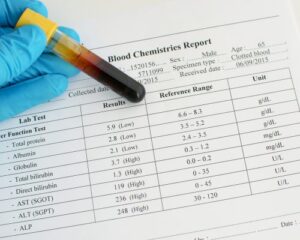 Bilirubin
Bilirubin
Bilirubin is a yellowy substance that is left after red blood cells die naturally. The UGT1A1 enzyme converts bilirubin into something that your liver can remove from your body. When this doesn’t happen properly, it builds up and we turn yellow (jaundice).
People with Gilbert’s Syndrome have about 30% of the usual amount of the UGT1A1 enzyme needed to process bilirubin.
This conversion or change is called ‘conjugation’, and is why Gilbert’s Syndrome is sometimes called by the real mouthful: ‘unconjugated hyperbilirubinemia’. In ordinary words this means that bilirubin hasn’t been joined up with other chemicals which help remove it from your blood.
If you want to see in more detail how bilirubin is made and processed in the body you can watch this short video:
Diagnosis
This symptom of Gilbert’s Syndrome is also one of the ways we’re diagnosed. The build up of bilirubin in the bloodstream can be measured in blood tests. Usually levels are below 1.2 milligrams per deciliter (mg/dL). If our liver is otherwise healthy, then doctors may diagnose Gilbert’s Syndrome. (In some countries a genetic test may be used to prove a diagnosis).
It’s not all about bilirubin!
The UGT1A1 enzyme isn’t just used in dealing with bilirubin, and this is what many doctors aren’t taught and aren’t aware of. Understanding that the lack of this enzyme has wider impacts than just on bilirubin is key to knowing why your body is working ok sometimes and not others.
This article notes that it affects how drugs work in your body
https://pubmed.ncbi.nlm.nih.gov/18518849/
“The variation of glucuronidation hidden behind Gilbert’s syndrome impacts drug therapy… The prediction of unwanted drug reactions associated with Gilbert’s syndrome will improve drug safety, therapeutic individualization and impact the drug-development process.”
Phase II pathways of the liver
Working in the Phase II pathways of the liver, the UGT1A1 enzyme also processes certain antibiotics, painkillers including paracetamol, common opiate based drugs used in pain relief or during surgery and even everyday substances like menthol and vanilla.

Want to find out more about the liver? This video gives a quick and simple explanation:
Smart Facts
Smart Fact 1
You can inherit the mutated gene (UGT1A1) from both parents, (where each of them have one copy of the gene and they may not have symptoms, but you do). Or you can inherit one copy of the gene from one parent, but it may still be enough to cause symptoms. https://ghr.nlm.nih.gov/condition/gilbert-syndrome#inheritance
Smart Fact 2
There are thought to be at least 113 variations of the mutation, which account for the variety of symptoms people Gilbert’s Syndrome have. Plus there are all the other genetic differences you have which impact on how your body works which can change how your body responds. https://pubmed.ncbi.nlm.nih.gov/18518849/
Smart Fact 3
This gene mutation can depend on your heritage. Broadly speaking, the most common variation is in people of African ancestry, followed by those of white European ancestry, where between 3% and 7% of the population are thought to have it. People of Asian ancestry are less likely to have Gilbert’s Syndrome, but exhibit higher levels of bilirubin in the bloodstream. https://www.ncbi.nlm.nih.gov/pmc/articles/PMC20948/
Well done! You’ve covered the science behind Gilbert’s Syndrome!
Want to dig deeper and do your own research? Pub Med is the national library of medicine in the US and you can search for Gilbert’s Syndrome or any other condition here : https://pubmed.ncbi.nlm.nih.gov/